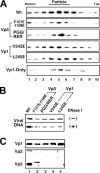Minor capsid proteins of simian virus 40 are dispensable for nucleocapsid assembly and cell entry but are required for nuclear entry of the viral genome
- PMID: 17267496
- PMCID: PMC1866110
- DOI: 10.1128/JVI.02664-06
Minor capsid proteins of simian virus 40 are dispensable for nucleocapsid assembly and cell entry but are required for nuclear entry of the viral genome
Abstract
We investigated the roles of simian virus 40 capsid proteins in the viral life cycle by analyzing point mutants in Vp1 and Vp2/3, as well as a deletion mutant lacking the Vp2/3 coding sequence. The Vp1 mutants (V243E and L245E) and the Vp2/3 mutants (F157E-I158E and P164R-G165E-G166R) were previously shown to be defective in Vp1-Vp2/3 interaction and to be noninfectious or poorly infectious, respectively. Here, we show that all these point mutants form stable particles following DNA transfection into cells. The Vp2/3-mutant particles contained very low levels of Vp2/3, whereas the Vp1 mutant particles contained no detectable Vp2/3. As expected, the deletion mutant also formed particles that were noninfectious. We further characterized the two Vp1 point mutants and the deletion mutant. All three mutant particles comprised Vp1 and histone-associated viral DNA, and all were able to enter cells. However, the mutant complexes failed to associate with host importins (owing to the loss of the Vp2/3 nuclear localization signal), and the mutant viral DNAs prematurely dissociated from the Vp1s, suggesting that the nucleocapsids did not enter the nucleus. Consistently, all three mutant particles failed to express large T antigen. Together, our results demonstrate unequivocally that Vp2/3 is dispensable for the formation of nucleocapsids. Further, the nucleocapsids' ability to enter cells implies that Vp1 contains the major determinants for cell attachment and entry. We propose that the major role of Vp2/3 in infectivity is to mediate the nuclear entry of viral DNA.
Figures




References
-
- Boura, E., D. Liebl, R. Spisek, J. Fric, M. Marek, J. Stokrova, V. Holan, and J. Forstova. 2005. Polyomavirus EGFP-pseudocapsids: Analysis of model particles for introduction of proteins and peptides into mammalian cells. FEBS Lett. 579:6549-6558. - PubMed
-
- Carbone, M., A. Reale, A. Di Sauro, O. Sthandier, M. I. Garcia, R. Maione, P. Caiafa, and P. Amati. 2006. PARP-1 interaction with VP1 capsid protein regulates polyomavirus early gene expression. J. Mol. Biol. 363:773-785. - PubMed
-
- Cavaldesi, M., M. Caruso, O. Sthandier, P. Amati, and M. I. Garcia. 2004. Conformational changes of murine polyomavirus capsid proteins induced by sialic acid binding. J. Biol. Chem. 279:41573-41579. - PubMed
-
- Chang, D., C. Y. Fung, W. C. Ou, P. C. Chao, S. Y. Li, M. Wang, Y. L. Huang, T. Y. Tzeng, and R. T. Tsai. 1997. Self-assembly of the JC virus major capsid protein, VP1, expressed in insect cells. J. Gen. Virol. 78:1435-1439. - PubMed
Publication types
MeSH terms
Substances
Grants and funding
LinkOut - more resources
Full Text Sources
Molecular Biology Databases
Research Materials

